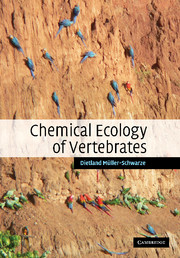Book contents
- Frontmatter
- Contents
- Preface
- Acknowledgements
- 1 The odorsphere: the environment for transmission of chemical signals
- 2 Properties of vertebrate semiochemicals
- 3 Odor production and release
- 4 Chemical cues in orientation and navigation
- 5 Chemoreception
- 6 Signaling pheromones I: discrimination and recognition
- 7 Signaling pheromones II: sex and alarm pheromones and evolutionary considerations
- 8 Intraspecific signals: priming pheromones
- 9 Development of intra- and interspecific chemical communication
- 10 Allomones I: chemical defense by animals
- 11 Allomones II: plant chemical defenses against herbivores
- 12 Kairomones and synomones
- 13 Practical applications of semiochemicals
- Glosssary
- References
- Index
9 - Development of intra- and interspecific chemical communication
Published online by Cambridge University Press: 23 November 2009
- Frontmatter
- Contents
- Preface
- Acknowledgements
- 1 The odorsphere: the environment for transmission of chemical signals
- 2 Properties of vertebrate semiochemicals
- 3 Odor production and release
- 4 Chemical cues in orientation and navigation
- 5 Chemoreception
- 6 Signaling pheromones I: discrimination and recognition
- 7 Signaling pheromones II: sex and alarm pheromones and evolutionary considerations
- 8 Intraspecific signals: priming pheromones
- 9 Development of intra- and interspecific chemical communication
- 10 Allomones I: chemical defense by animals
- 11 Allomones II: plant chemical defenses against herbivores
- 12 Kairomones and synomones
- 13 Practical applications of semiochemicals
- Glosssary
- References
- Index
Summary
The infant, the adult, the aged person, each has is own kind of smell, and … it might be possible, within certain limits, to discover the age of a person by his odor. In both sexes puberty, adolescence, early manhood and womanhood are marked by a gradual development of the adult odor of skin and excreta, in general harmony with the secondary sexual developments of hair and pigment.
h. h. ellisSexual Selection in ManThe nature–nurture problem revisited: in most vertebrates, early experience of certain odors, interwoven with genetically anchored developmental processes, produces lasting, often irreversible odor recognition, preferences, or avoidance. Such behavioral development often occurs during more or less defined critical windows in time. The development of responses to odors often precedes that of odor production. Neonates already orient towards odors, while many pheromones are not produced until adulthood. Even before hatching or birth, the journey of chemical communication starts in the egg or the uterus. Knowing how chemical communication and chemosensory responses to food or danger develop is essential in areas such as animal husbandry or human behavior.
Fish
Young fish are attracted to conspecific odors without prior experience. Examples are European eels, Anguilla anguilla (Pesaro et al., 1981), Arctic charr, Salvelinus alpinus (Olsén, 1987, 1990), and Atlantic salmon (Salmo salar). Kin recognition depends on early experience, as in Arctic charr. Fish reared with siblings later preferred water scented by unfamiliar siblings to water scented by non-siblings. By contrast, fish reared singly did not discriminate between water from siblings and water from non-siblings, even though they preferred sibling water to unscented tap water.
- Type
- Chapter
- Information
- Chemical Ecology of Vertebrates , pp. 227 - 245Publisher: Cambridge University PressPrint publication year: 2006



